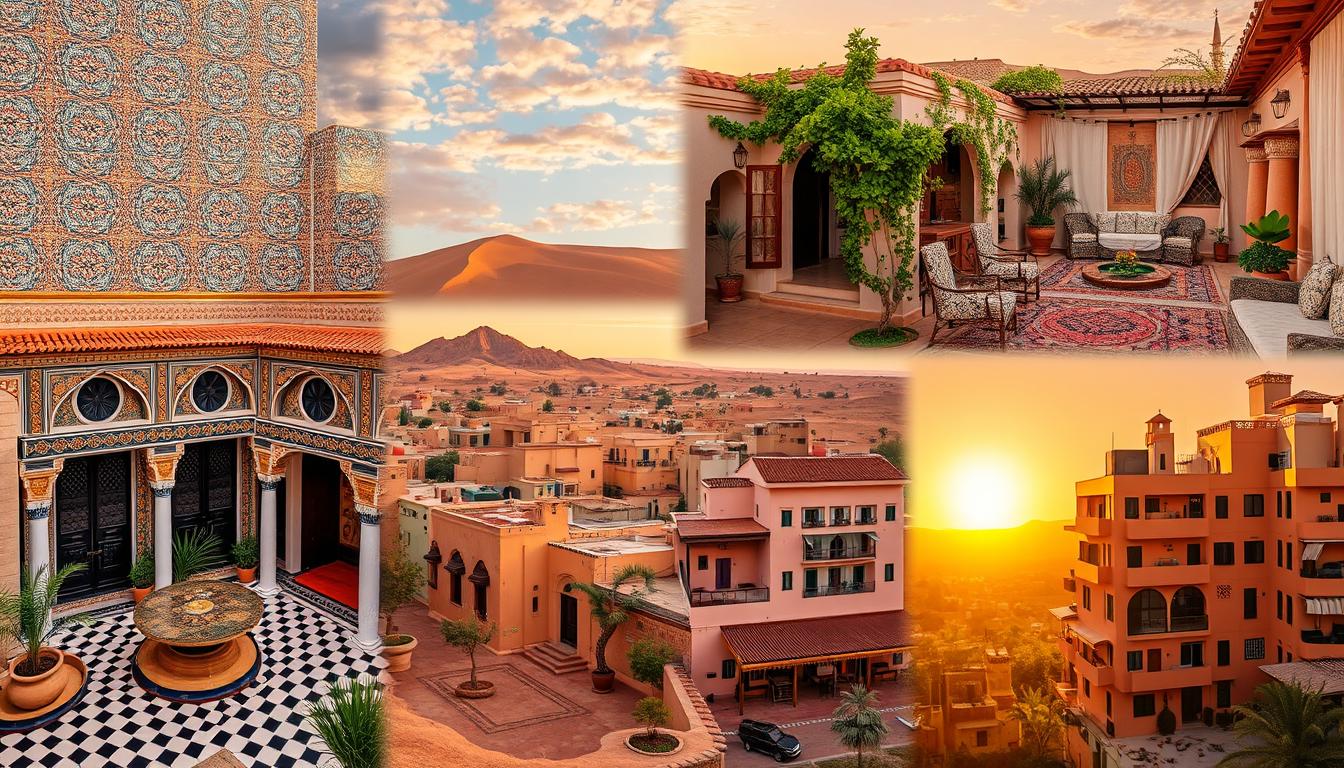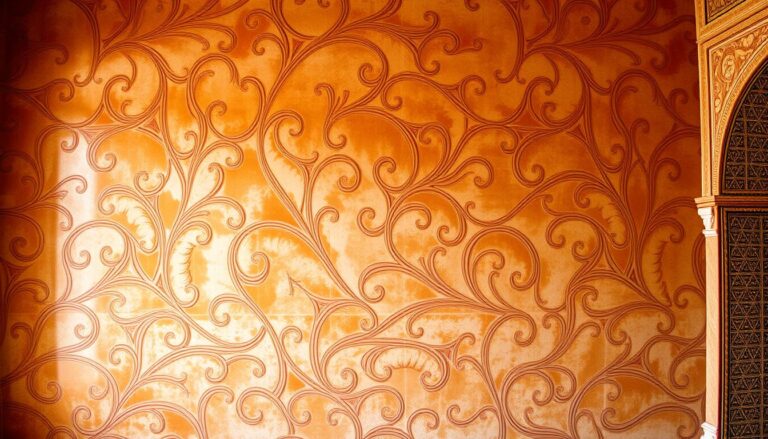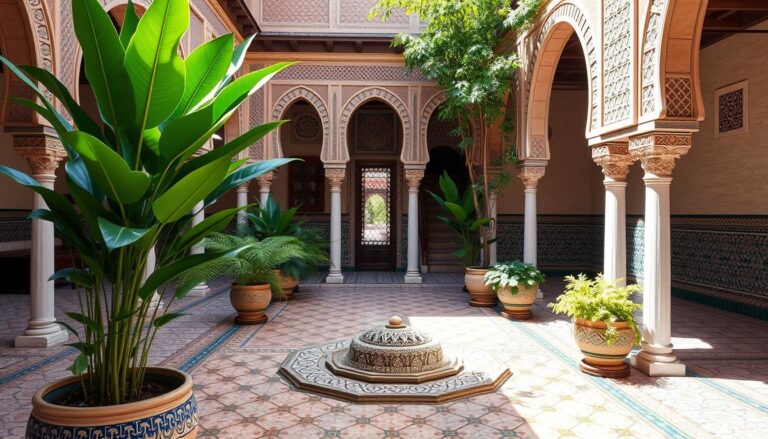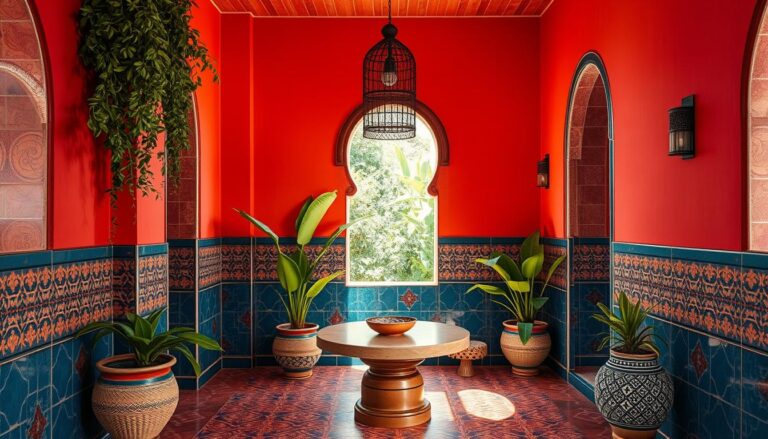Morocco is seeing big changes, with more people living in cities and fewer children being born. This is leading to new kinds of homes that meet today’s needs. From old courtyard houses to modern, versatile homes, Moroccan homes are changing. They are now more suited to city living and modern tastes.
But what’s driving these changes in homes? And how are they adapting to the 21st century?
Key Takeaways
- Moroccan homes are adapting to reflect changing demographic trends, such as urbanization and declining fertility rates.
- Traditional courtyard houses and historic mansions are being transformed to cater to modern lifestyles and tourism demands.
- Sustainable design features, such as passive solar principles and natural ventilation, are becoming more prevalent in Moroccan architecture.
- Architects and designers are exploring ways to create multi-functional, biophilic living spaces that integrate with the urban environment.
- The preservation of cultural heritage and the incorporation of traditional elements are crucial in shaping the evolution of Moroccan living spaces.
Traditional Moroccan Courtyard Houses
The traditional Moroccan houses, known as dars and riads, are famous for their focus on the inside. They have a central courtyard or patio, called the wast ad-dar. Riads have an interior garden, or riyad, in the middle.
Central Courtyards and Interior Gardens
The courtyard in a riad is often square or rectangular. It has a fountain or basin at its center, showing water’s sacred value. The area is filled with native trees like citrus, palms, and jasmine, making it peaceful.
The rooms around the courtyard are for public use. They are lit by the light coming through the gardens.
Inward-Focused Design for Privacy
The traditional Moroccan houses focus on privacy. They have few windows outside and a bent entrance to keep the inside private. This design shows the value of privacy and intimacy in the home.
The size and detail of the courtyard also show the owner’s status and wealth.
“The traditional Moroccan courtyard houses, known as Riads, are typically organized around a central open courtyard, with both public and private rooms facing inwards to maximize privacy.”
Historic Mansions and Riads
The historic Moroccan mansions and riads date back to the Marinid and Saadi periods. They show the architectural legacy of Morocco. These homes feature central courtyards, two-story galleries, and intricate zellij tilework.
Places like the 14th-century house in Fez and the Dar Demana mansion highlight the craftsmanship. They show how domestic architecture and madrasas share a common style. These homes are a testament to Morocco’s rich architectural history.
“Riads are the most quintessentially Moroccan accommodation, with a large number of traditional riads being converted into guesthouses for visitors.”
Riads, with their central courtyards, have made Morocco a top tourist spot. They offer an authentic Moroccan experience. Their design and details are truly unique.
- Riads have two or more levels around a central garden.
- The lower floor has three long rooms opening onto the garden.
- The upper levels have more rooms with inner balconies.
- Riads have open-topped living spaces for fresh air and sunlight.
- Kitchens and bathrooms are usually on the ground floor.
The design of riads goes back to the Roman era. It was influenced by Moroccan-Andalusian architecture. Riads were once homes for wealthy families in Morocco.
Over time, these homes have been updated. Modern bathrooms have been added, but their Moorish character remains. This has made them popular with visitors.
The restoration of riads in Marrakech and Fez has helped preserve Moroccan heritage. This work has led to UNESCO recognition. It ensures Morocco’s historic mansions and riads continue to attract visitors worldwide.
Evolution of living spaces in Morocco
Adapting to Urbanization and Modern Living
Morocco has changed a lot, moving towards more cities. This change has made old homes adapt to new ways of living. Now, homes mix old traditions with new needs, like open spaces and smart tech.
The urban middle class in Morocco wants modern homes. Builders are making homes with open-plan layouts for better use of space. They also add smart home technology for saving energy and making life easier.
There’s a big push for green homes in Morocco. Homes now use passive cooling strategies and biophilic elements to connect with nature. This makes homes better for the planet and healthier for people.
Morocco’s homes show how the country meets modern needs while keeping its culture alive. By mixing old and new, Moroccan homes are becoming symbols of progress and sustainability.
“The modern Moroccan home is a harmonious blend of cultural identity and contemporary living, reflecting the country’s ability to adapt to the challenges of urbanization while honoring its architectural legacy.”
Preserving Cultural Heritage
In Morocco’s historic cities, a special architectural legacy is being revived. Traditional riads, once homes, are now guesthouses and boutique hotels. This effort not only saves Moroccan architecture but also lets travelers dive into the country’s rich heritage.
Conversion of Riads into Guesthouses
Turning riads into guesthouses is a growing trend. It lets visitors experience Moroccan life from the past. Renovations keep the original look while adding modern comforts. This creates a special cultural tourism experience that shows Morocco’s timeless beauty.
“Preserving the cultural heritage of Morocco’s historic medinas is not just about maintaining the physical structures, but also about sharing the stories and traditions that make these spaces so special.” – Ashley Nowicki, sustainable tourism expert
Turning riads into guesthouses is key to saving Moroccan architecture. It keeps these architectural wonders interesting for both locals and visitors. It also helps the economy through cultural tourism.
As Morocco’s cities grow, riads turned into guesthouses show the country’s dedication to its past. These projects not only preserve but also celebrate Moroccan architecture. They give travelers a peek into the country’s history and traditions.
Sustainable and Smart Home Trends
Morocco is moving forward with a focus on green homes and smart tech. New homes are designed to save energy and use natural elements. This makes living spaces better for the planet and modern living.
Smart home systems and green energy solutions are becoming standard. This lets homeowners enjoy eco-friendly and high-tech homes. These homes meet today’s needs and care for the environment.
Morocco plans to make six cities smart by 2026. The first city, Casablanca, started in 2016. The goal is to improve public services through digital technology.
Smart cities focus on six key areas: economy, mobility, environment, life, people, and governance. They rely on people using tech to improve their daily lives.
Companies like IBM are helping build smart cities worldwide. Morocco is training engineers to create smart cities in Africa. This aims to tackle population growth and promote sustainable living.
Smart cities in Africa, including those in Morocco, could cut down on traffic losses. These losses currently cost Africa 2% of its GDP.
Morocco is leading the way in green and smart homes. This shows the country’s dedication to a sustainable and tech-savvy future.
Conclusion
The way people live in Morocco has changed a lot. The country’s buildings have adapted to new social, economic, and environmental needs. Now, Moroccan homes mix old traditions with new, smart designs.
As Morocco grows and changes, keeping its architectural history alive is key. It’s important to balance old traditions with new, green building ideas. This way, Moroccan homes will stay true to their roots while meeting today’s needs.
Moroccan architecture shows the country’s strength and ability to change. It reflects Morocco’s commitment to its past while looking forward to a sustainable future. The future of Moroccan homes promises a blend of tradition, modernity, and sustainability.
Source Links
- The Timeless Design of Moroccan Homes
- Historic house architecture in Morocco
- The Rich and Vibrant History of Moroccan Architecture.
- The Art Of The Moroccan Riad – Metropolis
- The Traditional Architecture of the Moroccan House
- A Brief History Of Riads Morocco’s Exquisite Accommodation
- A brief history of Moroccan riads – Marrakech Riads | Site Officiel
- Environmental and socio-cultural transition from traditional courtyard dwellings to contemporary housing practices in Morocco: insights from Arab and East Asian regions – Journal of Umm Al-Qura University for Engineering and Architecture
- Understanding the Urban Middle-Class and Its Housing Characteristics—Case Study of Casablanca, Morocco
- Cultural Partitions with Tourism | Syracuse University London
- Colonial Legacies in Morocco’s Urban Spaces: Policies of Modernization and Preservation
- Morocco will share its knowledge of smart cities in Africa
- Evolution of rural–urban health gaps in Morocco: 1992–2011
- The Challenge of Population Growth in Morocco – MERIP
- Proceedings of the GSAP 2006 Colloquium

The Editorial Team is a passionate group of Morocco enthusiasts dedicated to sharing the beauty, culture, and wonders of this captivating country. With diverse backgrounds and a deep love for travel, we strive to bring you engaging and informative content that inspires your Moroccan adventures. From uncovering hidden gems and sharing local insights to exploring mouthwatering cuisine and showcasing the vibrant lifestyle, our team is committed to providing you with valuable resources and exciting stories that enhance your exploration of Morocco. Join us on this journey as we celebrate the rich heritage and unforgettable experiences that make Morocco truly special.







